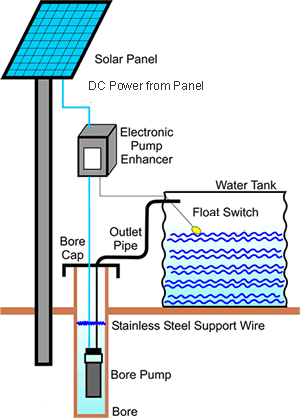Solar pumps have high initial costs but almost zero operational, maintenance costs and environmental costs. Now which one is cheaper in its life time operation of 20 years?
Solar Pumping Issues and Solutions in Pakistan
Faiz Mohammad Bhutta, Chapter Chairman | Renewable and Alternate Energy Society of Pakistan
Farmers of Pakistan are facing serious difficulties in irrigating their crops under such severe energy crisis and ever increasing diesel costs. There is a need to make efforts at all levels to facilitate the farmers in alternate ways of powering their water pumps. One of the economical ways is the solar pumping which can bring revolution in agriculture and provide farmers energy independence through solar pumping. According to one estimate, In Pakistan more than 1Million pumps are in use, out of which 750,000 are diesel driven pumps. If we replace 25% diesel pumps by solar pumps, we can save about 3570 MW of electricity. We here see what are the issues and solutions in solar pumping in Pakistan.
 First we try to understand how solar power pumping is different than Diesel driven pumping. In Diesel pump system, the pumps used in Pakistan are mostly Turbine, injection and end suction pumps powered by Diesel engines and Grid Electricity. The pump motor power varies from 10 HP to 35 HP. The pump efficiencies vary from 40 to 50% and mostly are over sized pumps and major problems are high maintenance and operational costs, seal leakages, frequent motor burnings & rewinding because of low Grid voltages, power fluctuations, wrong operation and wrongly designed pumps. In Solar Pump system, submersible pump is used which is 30 to 40 % more efficiency that Turbine, End Suction or Injection Pumps.
First we try to understand how solar power pumping is different than Diesel driven pumping. In Diesel pump system, the pumps used in Pakistan are mostly Turbine, injection and end suction pumps powered by Diesel engines and Grid Electricity. The pump motor power varies from 10 HP to 35 HP. The pump efficiencies vary from 40 to 50% and mostly are over sized pumps and major problems are high maintenance and operational costs, seal leakages, frequent motor burnings & rewinding because of low Grid voltages, power fluctuations, wrong operation and wrongly designed pumps. In Solar Pump system, submersible pump is used which is 30 to 40 % more efficiency that Turbine, End Suction or Injection Pumps.
In comparison with the Diesel pump system, following are the benefits of solar pump system;
- Simple installation
- No moving part.
- Noise less operation
- No emission of carbon dioxide and sulphur dioxide
- 20 years life
- Zero Operation and maintenance cost
- No fuel required.
- Real energy independence.
- Un-manned operation ( automatic start and stop)
Now question arises that when there are so many benefits of solar pumps then what are the issues and their solutions to increase the solar pump installations in Pakistan.
The good practice to compare the pumps cost is to calculate the Life Cycle Cost (Cost of pump over its life time operation) and Life Cycle Cost components of the pumps are as under,
- Initial cost or Purchase cost or Upfront Cost
- Operation cost ( Diesel, fuel transportation, labor etc)
- Maintenance and Replacement Costs (Repair, replacements of diesel engine, Pump and its parts)
- Environmental costs ( Spills, contaminations, leakages, noise and emissions)
- Disposal cost ( Pump cost when it is disposed off to buy new Pump)
Diesel driven pumps have low initial cost but high operational, maintenance and environmental costs. Solar pumps have high initial costs but almost zero operational, maintenance costs and environmental costs. Now which one is cheaper in its life time operation of 20 years? If we calculate the Life Cycle costs of both pumps, we can easily decide which type of pump is economical. The Life Cycle Cost (all-inclusive cost) takes a long term approach and is calculated over a twenty year period, which is also the minimum life expectancy of a solar panel. The cost comparisons done by economists and financial experts revealed that diesel pumps are on average two to four times more expensive over a 20 year period than solar pumps for pumping the same average amount of water per day! At low hydraulic load the solar pump Life cycle Cost is as low as 20% of the Diesel Pump Life Cycle cost. At higher hydraulic loads this value reaches 55% which means that the solar Pump option still provides a solution at half the life cycle cost of the Diesel drive pump option.
Key issue in the growth of solar pumps is the high upfront cost of solar pump and our farmers cannot bear this high up-front cost and remedy is to apply a mechanism by which farmers should pay the upfront cost in 36 equal installments and Banks can provide financing to resolve this issue. Second solution to this problem is that Government (WAPDA) should provide subsidy of 30% to farmers on purchase of solar pumps and WAPDA will be the beneficiary of the energy saving through solar pumps.
Some farmers have the opinion to convert existing inefficient diesel driven pumps to solar driven pumps but to my point of view it will be costly option as you need a high solar power system to run the existing pumps and the cost will further increase. Solar pumps system use high efficiency stainless steel submersible pumps and they consume less energy as compared to Diesel driven pumps.
Second issue is designing skills to design and size the correct pump. The solar pump manufacturers can train the designers and installers through their customized software to correctly design the solar pump as solar pumping sizing is different than Diesel driven pumps. Lorentz Pumps has very excellent pump sizing software by which the pumps can be sized in very accurate manner as per farmer’s requirements. Also solar pumping subject can be included in DAE and BTECH curriculum.
.jpg)
Water Quality is another issue in case of installation of solar pumps. Acidic water is dangerous for seals of submersible pumps. So before installation of solar pumps, water quality analysis should be done.
Bore integrity is another issue as solar pump system uses submersible pumps. Bore quality, Bore testing, draw down and aquifer chemistry and profile analysis are some of the issues which need to be addressed while installing the solar pump.
In almost all the countries there is subsidy on purchase of solar pumps and WAPDA being the ultimate beneficiary of the electrical energy saving can provide 30% subsidy to farmers upon purchase of the solar pumps.
The farmers have very low confidence of solar pumps technology and Agriculture & Irrigation Departments can fix some budgets for demonstration projects by which solar pumps can be installed as demonstration units and this can enhance confidence of the farmers.
The solar pump import duties are another issue. As per SRO 575, the pumps operating on solar is exempted from custom duty and sales tax but PCT code mentions submersible pump only which is not exempted. Clear SRO is required to exempt solar submersible pumps from all import duties.
Farmer representative societies and Associations should come forward to resolve the financing issue of solar Pumps. Farmers Associates of Pakistan (FAP) is trying its best to bring the Farmers, suppliers and Banks together to resolve the above mentioned issues.
Government, suppliers, Farmer Associations and Banks join hands to resolve the issues and bring relief to farmers and this will bring prosperity in the country and will result in increase in GDP of the country.

BREIF INTRODUCTION OF ENGR. FAIZ MOHAMMAD BHUTTA
 Faiz Mohammad Bhutta is an engineer plus MBA. He has 35 years of experience of serving at technical and managerial posts in national and multinational companies; He is currently serving as General Manager Izhar Energy Services, Izhar Group of Companies. Apart from his professional career, he has served as visiting teacher on engineering and management subjects in Air University, COMSATS University and UMT.
Faiz Mohammad Bhutta is an engineer plus MBA. He has 35 years of experience of serving at technical and managerial posts in national and multinational companies; He is currently serving as General Manager Izhar Energy Services, Izhar Group of Companies. Apart from his professional career, he has served as visiting teacher on engineering and management subjects in Air University, COMSATS University and UMT.
He has also contributed as PEC Task force member on Building Energy Code 2011.
He is chairman of Renewable and Alternate Energy Association of Pakistan Lahore Chapter. He is member of organizations namely International Solar Society Germany; ASHRAE USA, Executive Member REAP, Life member of PEC , Life Member of HVACR Society, Life Member of IEP, Life member of IEEEP and member of MAP. He is master trainer on solar PV from GIZ Pakistan and resource person from PEC on solar Energy for CPD Courses.
He is a writer & Trainer also and his articles are published in Energy Update, EIR, HVACR Journal, TechnoBiz, Engineering Horizon, Energy Magazine and International energy magazines etc.
He has attended lot of national and international EXPO and Conferences on Alternate Energy in China and Germany.
The content & opinions in this article are the author’s and do not necessarily represent the views of AltEnergyMag
Comments (0)
This post does not have any comments. Be the first to leave a comment below.
Featured Product

